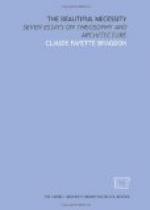II
UNITY AND POLARITY
Theosophy, both as a philosophy, or system of thought, which discovers correlations between things apparently unrelated, and as a life, or system of training whereby it is possible to gain the power to perceive and use these correlations for worthy ends, is of great value to the creative artist, whose success depends on the extent to which he works organically, conforming to the cosmic pattern, proceeding rationally and rhythmically to some predetermined end. It is of value no less to the layman, the critic, the art amateur—to anyone in fact who would come to an accurate and intimate understanding and appreciation of every variety of esthetic endeavor. For the benefit of such I shall try to trace some of those correlations which theosophy affirms, and indicate their bearing upon art, and upon the art of architecture in particular.
One of the things which theosophy teaches is that those transcendent glimpses of a divine order and harmony throughout the universe vouchsafed the poet and the mystic in their moments of vision are not the paradoxes—the paronomasia as it were—of an intoxicated state of consciousness, but glimpses of reality. We are all of us participators in a world of concrete music, geometry and number—a world of sounds, odors, forms, motions, colors, so mathematically related and coordinated that our pigmy bodies, equally with the farthest star, vibrate to the music of the spheres. There is a Beautiful Necessity which rules the world, which is a law of nature and equally a law of art, for art is idealized creation: nature carried to a higher power by reason of its passage through a human consciousness. Thought and emotion tend to crystallize into forms of beauty as inevitably as does the frost on a window pane. Art therefore in one of its aspects is the weaving of a pattern, the communication of an order and a method to the material or medium employed. Although no masterpiece was ever created by the conscious following to set rules, for the true artist works unconsciously, instinctively, as the bird sings or as the bee builds its honey-cell, yet an analysis of any masterpiece reveals the fact that its author (like the bird and the bee) has “followed the rules without knowing them.”
Helmholtz says, “No doubt is now entertained that beauty is subject to laws and rules dependent on the nature of human intelligence. The difficulty consists in the fact that these laws and rules, on whose fulfilment beauty depends, are not consciously present in the mind of the artist who creates the work, or of the observer who contemplates it.” Nevertheless they are discoverable, and can be formulated, after a fashion. We have only to read aright the lessons everywhere portrayed in the vast picture-books of nature and of art.




